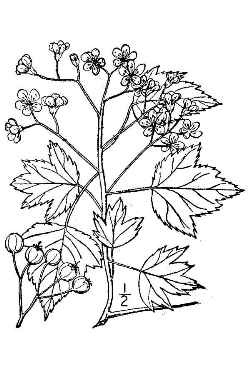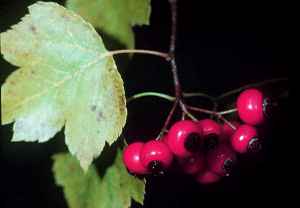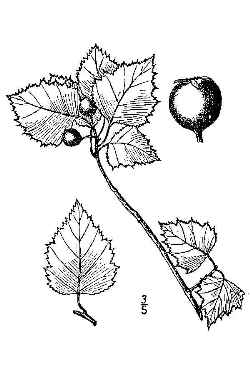
Britton, N.L., and A. Brown. 1913. Illustrated flora of the northern states and Canada. Vol. 2: 299. Courtesy of Kentucky Native Plant Society.
Sunset®: 1-12, 14-17
USDA: 4-9
Sun Exposure: Full sun to partial sun
Origin: Eastern USA (Virginia to Alabama)
Growth Habits: Small deciduous tree, 20 feet tall (6 m), 20 feet wide (6 m); alternate leaves, 3 to 5 lobes, about 2 inches long (5 cm)
Flowers: White flowers
Watering Needs: Prefers moist, well-drained soil
Propagation: Seeds and rooted cuttings
Propagation: Seed
- by seeds, in spring. Germinates at 70-85 degrees F. The seeds can be harvested in autumn. The seeds need stratify 40F 4-5mo.. The usual germination temperature is 70-85 degrees F.

Robert H. Mohlenbrock. USDA SCS. 1991. Southern wetland flora: Field office guide to plant species.

Crataegus populifolia, Britton, N.L., and A. Brown. 1913. Illustrated flora of the northern states and Canada. Vol. 2: 308.
Blooming Habits:
Blankets of malodorous white 2 inches wide inflorescences in June, for a couple of weeks.
Fruiting Habits:
Green turning turning progressively to bright orange when ripe in early autumn. The fruit can be used to make jellies.
Culture:
Least susceptible to fireblight
Desert-Tropicals is dedicated to provide gardening advice, gardening ideas, and information about flower of all kind for landscape and collections.We try to check carefully the identification of the plants on the illustrations as well as the other information from the page, but occasionally errors do occur. if you notice anything that needs to be changed please contact us.Thanks.
© 1998-2020 Philippe Faucon, All Rights Reserved.